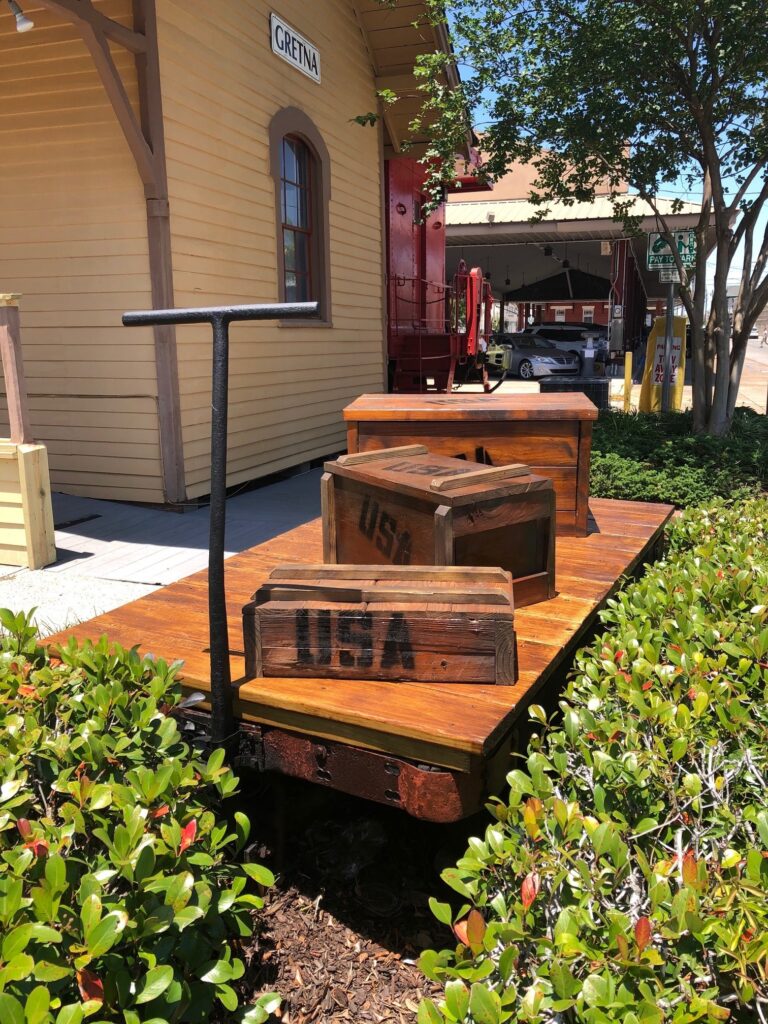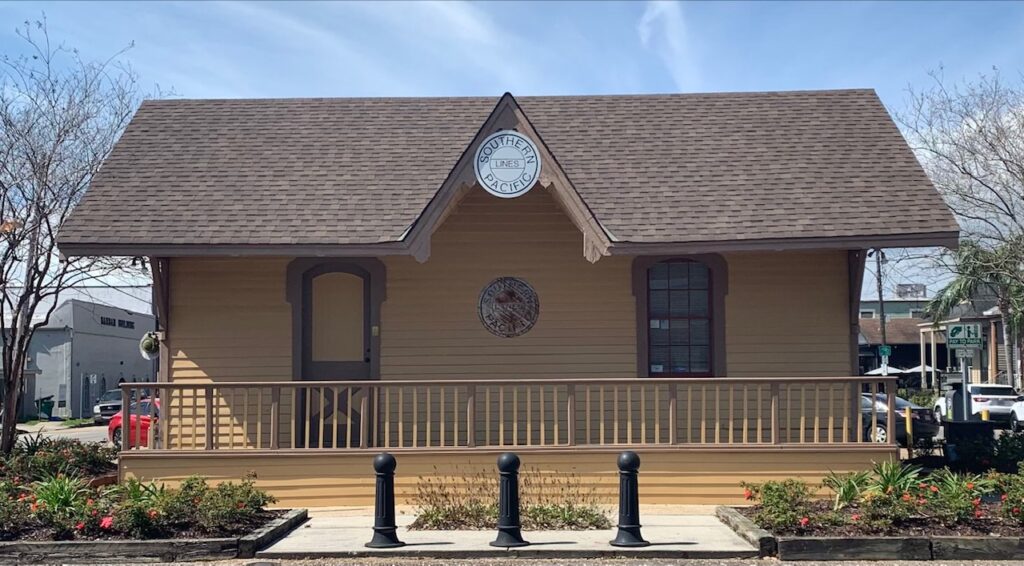Downtown Gretna sports two train depots that date back to the turn of the 20th century and one with a real train caboose! Not realizing just how rich in history these three landmarks really are, folks likely ride right past them without notice.

The Southern Pacific Freight Depot is a Gretna landmark located at 4th Street and Huey P. Long Avenue across the street from the Gretna Cultural Center for the Arts. Built in 1906 in a unique style not typically found in Louisiana, it is owned by the Gretna Historical Society, but sits on City of Gretna owned land. For a long time it served as the Visitor’s Center, but will soon be utilized as the new office for the Gretna Farmers Market.

The freight depot went full circle! It was constructed at its present site, but had been physically relocated to 4th Street near the mid-century built Jefferson Parish Courthouse. It was threatened to be torn down in the early 1980s, when former Mayor Ronnie Harris, a preservationist, made arrangements for the old depot to be moved back to its original location.
The interior of the building was given a facelift recently by the historical society and the grounds were beautifully landscaped featuring an old railroad push cart surrounded by azaleas.
Behind the freight depot, one can’t miss the little red Caboose!
Built in 1951 by the Illinois Central Railroad Company, there is no known information about the caboose’s service to the railroad company.
In 1986 the caboose was relocated to its present site by a group of industrious Gretna Historical Society members. Some way or another, the caboose had been privately owned and used as a Terrytown restaurant called “The Brothers Three.”

Society members heard that the restaurant was closing and took on the mission of getting the red caboose to the historic district where they believed it belonged. It was thought that the caboose would be a perfect complement to the old railroad freight depot that had already been relocated back to its present location.
The expense and logistics of moving the caboose was too much of a financial burden for the historical society to manage alone. Mary Grace Curry, society president who was also largely responsible for getting Gretna on the National Registry worked with then serving Mayor Ronnie Harris to get the project moving. They got badly needed support when La. St. Representative Joseph Toomy, a lifelong Gretna resident stepped up to help.
Joe Toomy knew the owner of B & G Crane Service who generously moved the caboose at no cost. The local utility company lifted power lines along the route to get the caboose to downtown Gretna. Moving the caboose was quite the spectacle.
The GHS project of relocating the caboose and taking on the ownership duties created a new Gretna landmark! Today the caboose houses railroad memorabilia. It has been closed due to Covid-19 restrictions. Prearranged tours, field trips and bus trips were offered in the past and will be available again post-pandemic.
Likely the least recognized railroad-related landmark is the Texas and Pacific Railroad Station located at 139 3rd Street, behind Gretna City Hall. It is listed on the prestigious National Register of Historical Places. Built-in 1905, the red brick building is a bungalow with wrought iron brackets and a gabled parapet. This depot replaced a pre-Civil War wood structure close to the rail ferry.

The Texas Pacific Railroad, owned by Jay Gould, established a terminal in Gretna in 1881. Passenger and freight rail cars were transported across the Mississippi River on railroad barges from the Gretna terminal until the construction of the Huey P. Long Bridge in 1935.
The Gretna Station was the starting point of all Texas-Pacific rails going north and west of the mighty Mississippi. After passengers boarded in New Orleans, the cars were ferried across the river and assembled into a train on 3rd Street in front of the Gretna Station.
For 30 years, the little station was very active as many New Orleans passengers preferred to cross the Mississippi River on the Jackson Avenue Ferry and board the train in Gretna. Many veterans from various wars traveled through the station as they were deployed and returned after serving in the military.
In 1935, the station fell on hard times as it was less needed once the Huey P. Long vehicular and railroad bridge opened, connecting east with west. In post WWII years, the Texas-Pacific Railroad was purchased by the Missouri-Pacific Railroad. Being declared access baggage by M-P, the little station was donated to the City of Gretna.

In 1993, the Louisiana State Railroad Museum became the new occupant of the little station. It received a facelift. With most of its modernism ripped out, exposing its very ornate embossed tin ceiling, restoration moved very slowly as funds became available. After 60 years of mostly desolation and idleness, Gretna’s Texas-Pacific Station was restored to its 1905 appearance.
The little station began its most unglamorous role when it became Gretna’s collection office for auto traffic fines. It has since served as offices for various entities. With the Gretna Farmers Market moving out soon, at this time there are no immediate plans for the site. It will be interesting to see what’s next for this important landmark.
###



